Staining Analysis of Resin Cements and Their Effects on Colour and Translucency Changes in Lithium Disilicate Veneers
Abstract
1. Introduction
2. Materials and Methods
2.1. Specimen Preparation
2.2. Staining
2.3. Colour and Translucency Parameter
2.4. Sorption and Solubility
2.5. Statistical Analysis
3. Results
3.1. Resin Cements
3.2. Cemented LiSi Veneers
4. Discussion
5. Conclusions
Author Contributions
Funding
Institutional Review Board Statement
Data Availability Statement
Acknowledgments
Conflicts of Interest
References
- Araujo, E.; Perdigao, J. Anterior Veneer Restorations—An Evidence-based Minimal-Intervention Perspective. J. Adhes. Dent. 2021, 23, 91–110. [Google Scholar]
- Klein, P.; Spitznagel, F.A.; Zembic, A.; Prott, L.S.; Pieralli, S.; Bongaerts, B.; Metzendorf, M.I.; Langner, R.; Gierthmuehlen, P.C. Survival and Complication Rates of Feldspathic, Leucite-Reinforced, Lithium Disilicate and Zirconia Ceramic Laminate Veneers: A Systematic Review and Meta-Analysis. J. Esthet. Restor. Dent. 2024. [Google Scholar] [CrossRef]
- Maletin, A.; Knezevic, M.J.; Koprivica, D.D.; Veljovic, T.; Puskar, T.; Milekic, B.; Ristić, I. Dental Resin-Based Luting Materials-Review. Polymers 2023, 15, 4156. [Google Scholar] [CrossRef] [PubMed]
- Radovic, I.; Monticelli, F.; Goracci, C.; Vulicevic, Z.R.; Ferrari, M. Self-adhesive resin cements: A literature review. J. Adhes. Dent. 2008, 10, 251–258. [Google Scholar] [PubMed]
- Miotti, L.L.; Follak, A.C.; Montagner, A.F.; Pozzobon, R.T.; da Silveira, B.L.; Susin, A.H. Is Conventional Resin Cement Adhesive Performance to Dentin Better Than Self-adhesive? A Systematic Review and Meta-Analysis of Laboratory Studies. Oper. Dent. 2020, 45, 484–495. [Google Scholar] [CrossRef]
- Barbon, F.J.; Moraes, R.R.; Calza, J.V.; Perroni, A.P.; Spazzin, A.O.; Boscato, N. Inorganic filler content of resin-based luting agents and the color of ceramic veneers. Braz. Oral Res. 2018, 32, e49. [Google Scholar] [CrossRef] [PubMed]
- Comba, A.; Paolone, G.; Baldi, A.; Vichi, A.; Goracci, C.; Bertozzi, G.; Scotti, N. Effects of Substrate and Cement Shade on the Translucency and Color of CAD/CAM Lithium-Disilicate and Zirconia Ceramic Materials. Polymers 2022, 14, 1778. [Google Scholar] [CrossRef] [PubMed]
- Gomes, C.; Martins, F.; Reis, J.A.; Mauricio, P.D.; Ramirez-Fernandez, M.P. Color Assessment of Feldspathic Ceramic with Two Different Thicknesses, Using Multiple Polymeric Cements. Polymers 2023, 15, 397. [Google Scholar] [CrossRef]
- Almeida, J.R.; Schmitt, G.U.; Kaizer, M.R.; Boscato, N.; Moraes, R.R. Resin-based luting agents and color stability of bonded ceramic veneers. J. Prosthet. Dent. 2015, 114, 272–277. [Google Scholar] [CrossRef]
- Pissaia, J.F.; Guanaes, B.K.A.; Kintopp, C.C.A.; Correr, G.M.; da Cunha, L.F.; Gonzaga, C.C. Color stability of ceramic veneers as a function of resin cement curing mode and shade: 3-year follow-up. PLoS ONE 2019, 14, e0219183. [Google Scholar] [CrossRef]
- Ramos, N.C.; Luz, J.N.; Valera, M.C.; Melo, R.M.; Saavedra, G.; Bresciani, E. Color Stability of Resin Cements Exposed to Aging. Oper. Dent. 2019, 44, 609–614. [Google Scholar] [CrossRef] [PubMed]
- Strazzi Sahyon, H.B.; Chimanski, A.; Yoshimura, H.N.; Dos Santos, P.H. Effect of previous photoactivation of the adhesive system on the color stability and mechanical properties of resin components in ceramic laminate veneer luting. J. Prosthet. Dent. 2018, 120, 631.e1–631.e6. [Google Scholar] [CrossRef] [PubMed]
- Ural, C.; Duran, I.; Tatar, N.; Ozturk, O.; Kaya, I.; Kavut, I. The effect of amine-free initiator system and the polymerization type on color stability of resin cements. J. Oral Sci. 2016, 58, 157–161. [Google Scholar] [CrossRef][Green Version]
- Yang, Y.; Wang, Y.; Yang, H.; Chen, Y.; Huang, C. Effect of aging on color stability and bond strength of dual-cured resin cement with amine or amine-free self-initiators. Dent. Mater. J. 2022, 41, 17–26. [Google Scholar] [CrossRef] [PubMed]
- Palmeira, A.R.B.; Vieira-Junior, W.F.; Amaral, F.L.; Basting, R.T.; Turssi, C.P.; Franca, F.M. Influence of ceramic laminate on water sorption, solubility, color stability, and microhardness of resin cements. Am. J. Dent. 2019, 32, 229–234. [Google Scholar] [PubMed]
- Shiozawa, M.; Takahashi, H.; Asakawa, Y.; Iwasaki, N. Color stability of adhesive resin cements after immersion in coffee. Clin. Oral Investig. 2015, 19, 309–317. [Google Scholar] [CrossRef] [PubMed]
- Yagci, F.; Balkaya, H.; Demirbuga, S. Discoloration Behavior of Resin Cements Containing Different Photoinitiators. Int. J. Periodontics Restor. Dent. 2021, 41, e113–e120. [Google Scholar] [CrossRef]
- Yu, H.; Cheng, S.L.; Jiang, N.W.; Cheng, H. Effects of cyclic staining on the color, translucency, surface roughness, and substance loss of contemporary adhesive resin cements. J. Prosthet. Dent. 2018, 120, 462–469. [Google Scholar] [CrossRef] [PubMed]
- Mazzitelli, C.; Paolone, G.; Sabbagh, J.; Scotti, N.; Vichi, A. Color Stability of Resin Cements after Water Aging. Polymers 2023, 15, 655. [Google Scholar] [CrossRef] [PubMed]
- Fujishima, S.; Shinya, A.; Shiratori, S.; Kuroda, S.; Hatta, M.; Gomi, H. Long-term color stability of light-polymerized resin luting agents in different beverages. J. Prosthodont. Res. 2021, 65, 515–520. [Google Scholar] [CrossRef]
- Alkhudhairy, F.; Vohra, F.; Naseem, M.; Owais, M.M.; Amer, A.H.B.; Almutairi, K.B. Color stability and degree of conversion of a novel dibenzoyl germanium derivative containing photo-polymerized resin luting cement. J. Appl. Biomater. Funct. Mater. 2020, 18, 2280800020917326. [Google Scholar] [CrossRef] [PubMed]
- Miletic, V.; Pour Ronagh, A. Staining analysis of resin cements and effects on veneer restorations. In Proceedings of the CED/NOF-IADR 2024 Oral Health Research Congress, Geneva, Switzerland, 12–14 September 2024. [Google Scholar]
- Palandi, S.d.S.; Kury, M.; Picolo, M.Z.D.; Esteban Florez, F.L.; Cavalli, V. Effects of black tea tooth staining previously to 35% hydrogen peroxide bleaching. Braz. J. Oral Sci. 2022, 22, e238082. [Google Scholar] [CrossRef]
- ISO 4049:2019; Dentistry—Polymer-Based Restorative Materials. ISO: Geneva, Switzerland, 2019.
- Miletic, V.; Stasic, J.N.; Komlenic, V.; Petrovic, R. Multifactorial analysis of optical properties, sorption, and solubility of sculptable universal composites for enamel layering upon staining in colored beverages. J. Esthet. Restor. Dent. 2021, 33, 943–952. [Google Scholar] [CrossRef] [PubMed]
- Manojlovic, D.; Lenhardt, L.; Milicevic, B.; Antonov, M.; Miletic, V.; Dramicanin, M.D. Evaluation of Staining-Dependent Colour Changes in Resin Composites Using Principal Component Analysis. Sci. Rep. 2015, 5, 14638. [Google Scholar] [CrossRef] [PubMed]
- Ardu, S.; Duc, O.; Di Bella, E.; Krejci, I.; Daher, R. Color stability of different composite resins after polishing. Odontology 2018, 106, 328–333. [Google Scholar] [CrossRef] [PubMed]
- Paolone, G.; Formiga, S.; De Palma, F.; Abbruzzese, L.; Chirico, L.; Scolavino, S.; Goracci, C.; Cantatore, G.; Vichi, A. Color stability of resin-based composites: Staining procedures with liquids—A narrative review. J. Esthet. Restor. Dent. 2022, 34, 865–887. [Google Scholar] [CrossRef] [PubMed]
- Paravina, R.D.; Perez, M.M.; Ghinea, R. Acceptability and perceptibility thresholds in dentistry: A comprehensive review of clinical and research applications. J. Esthet. Restor. Dent. 2019, 31, 103–112. [Google Scholar] [CrossRef]
- Salgado, V.E.; Borba, M.M.; Cavalcante, L.M.; de Moraes, R.R.; Schneider, L.F. Effect of photoinitiator combinations on hardness, depth of cure, and color of model resin composites. J. Esthet. Restor. Dent. 2015, 27 (Suppl. 1), S41–S48. [Google Scholar] [CrossRef]
- Salgado, V.E.; Albuquerque, P.P.; Cavalcante, L.M.; Pfeifer, C.S.; Moraes, R.R.; Schneider, L.F. Influence of photoinitiator system and nanofiller size on the optical properties and cure efficiency of model composites. Dent. Mater. 2014, 30, e264–e271. [Google Scholar] [CrossRef]
- Kowalska, A.; Sokolowski, J.; Bociong, K. The Photoinitiators Used in Resin Based Dental Composite—A Review and Future Perspectives. Polymers 2021, 13, 470. [Google Scholar] [CrossRef] [PubMed]
- Cinelli, F.; Scaminaci Russo, D.; Nieri, M.; Giachetti, L. Stain Susceptibility of Composite Resins: Pigment Penetration Analysis. Materials 2022, 15, 4874. [Google Scholar] [CrossRef] [PubMed]
- Ghavam, M.; Amani-Tehran, M.; Saffarpour, M. Effect of accelerated aging on the color and opacity of resin cements. Oper. Dent. 2010, 35, 605–609. [Google Scholar] [CrossRef]
- Archegas, L.R.; Freire, A.; Vieira, S.; Caldas, D.B.; Souza, E.M. Colour stability and opacity of resin cements and flowable composites for ceramic veneer luting after accelerated ageing. J. Dent. 2011, 39, 804–810. [Google Scholar] [CrossRef]
- 3M. Available online: https://multimedia.3m.com/mws/media/1932430O/3m-relyx-universal-cement-technical-product-profile.pdf (accessed on 16 February 2021).
- da Silva, S.F.; de Araujo Regis, M.; Francci, C.E. The capacity of conservative preparations for lithium disilicate glass-ceramic laminates luted with different resin cements to mask different substrate shades: A minimally invasive esthetic approach. J. Esthet. Restor. Dent. 2024, 36, 761–769. [Google Scholar] [CrossRef] [PubMed]
- ISO 4049:2000; Dentistry—Polymer-Based Filling, Restorative And Luting Materials. ISO: Geneva, Switzerland, 2000.
- Aljohani, A.; Bashiri, R.; Vasconcellos, A.B.; Suliman, A.A.; Sulaiman, T.A. Impact of altering the dispensing methods of resin-based cements on their physical and bonding qualities. J. Prosthet. Dent. 2024, 132, 1327.e1–1327.e7. [Google Scholar] [CrossRef] [PubMed]
- Sokolowski, G.; Szczesio, A.; Bociong, K.; Kaluzinska, K.; Lapinska, B.; Sokolowski, J.; Domarecka, M.; Lukomska-Szymanska, M. Dental Resin Cements-The Influence of Water Sorption on Contraction Stress Changes and Hydroscopic Expansion. Materials 2018, 11, 973. [Google Scholar] [CrossRef] [PubMed]
- Yli-Urpo, T.; Lassila, L.; Narhi, T.; Vallittu, P. Cement layer thickness and load-bearing capacity of tooth restored with lithium-disilicate glass ceramic and hybrid ceramic occlusal veneers. Dent. Mater. 2025, 41, 212–219. [Google Scholar] [CrossRef] [PubMed]
- Available online: https://www.gc.dental/australasia/sites/australasia.gc.dental/files/products/downloads/gcinitiallisiblock/ifu/GC%20INITIAL%20LISI%20BLOCK%20-%20IFU.pdf (accessed on 16 February 2021).

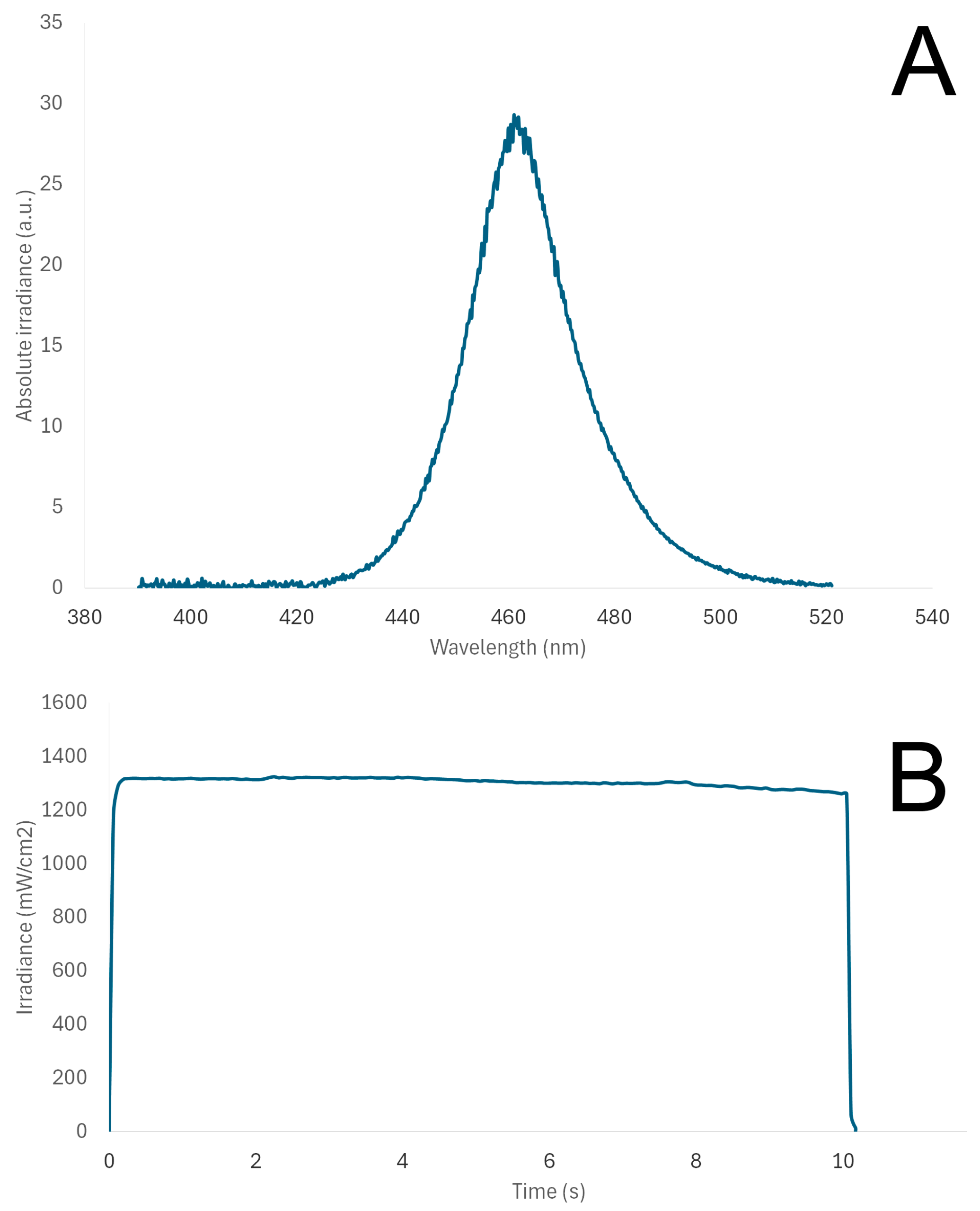
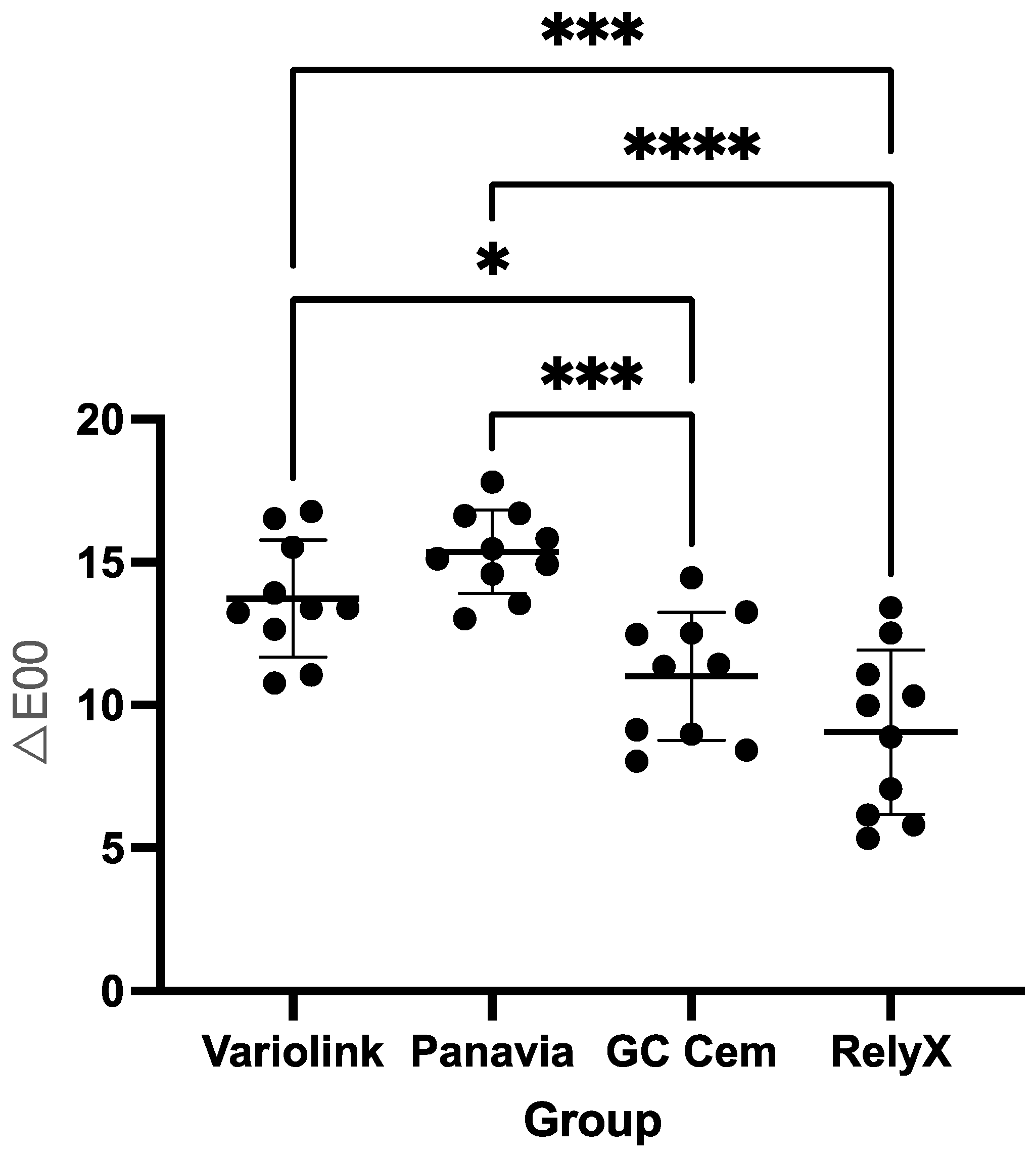
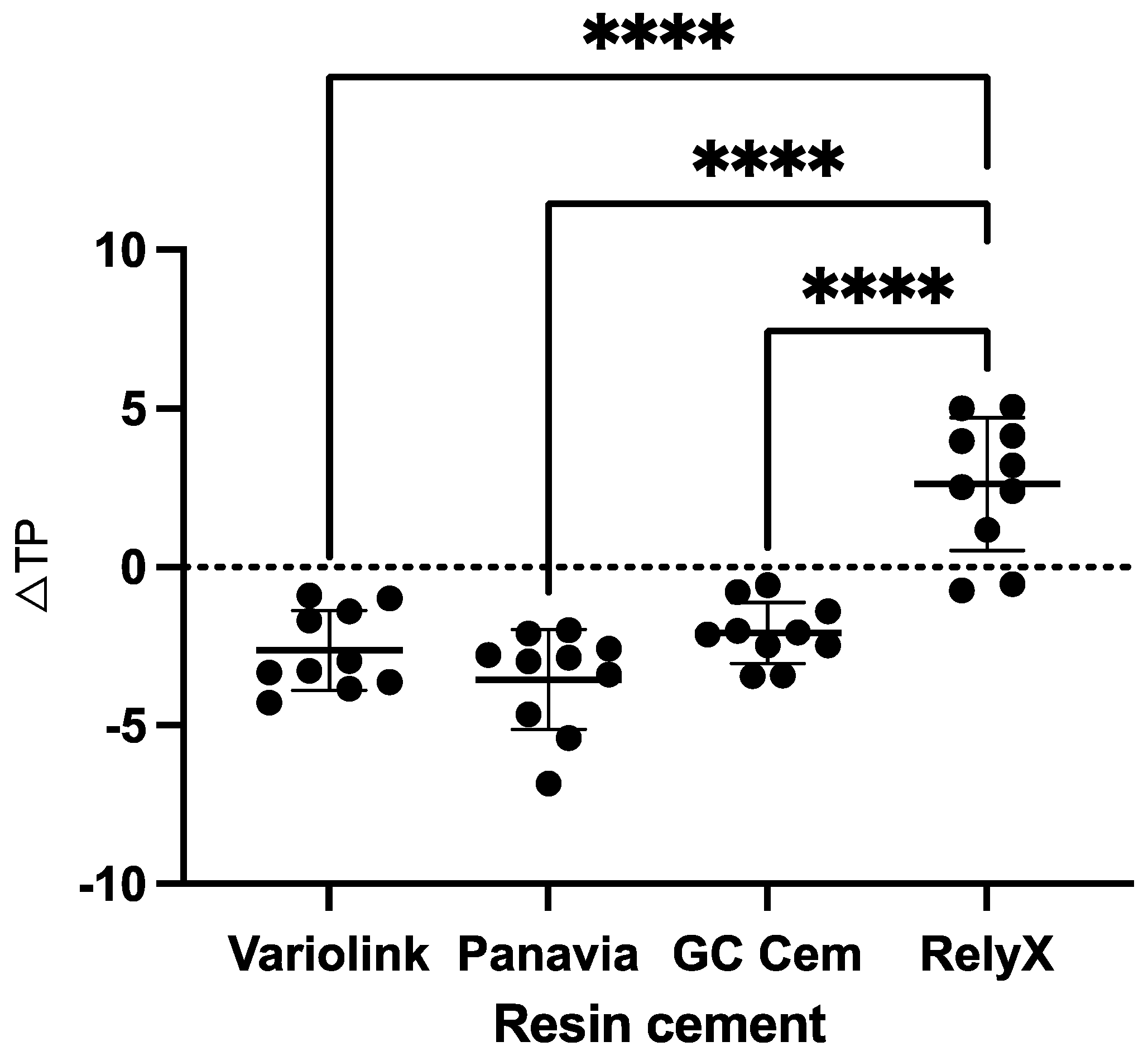

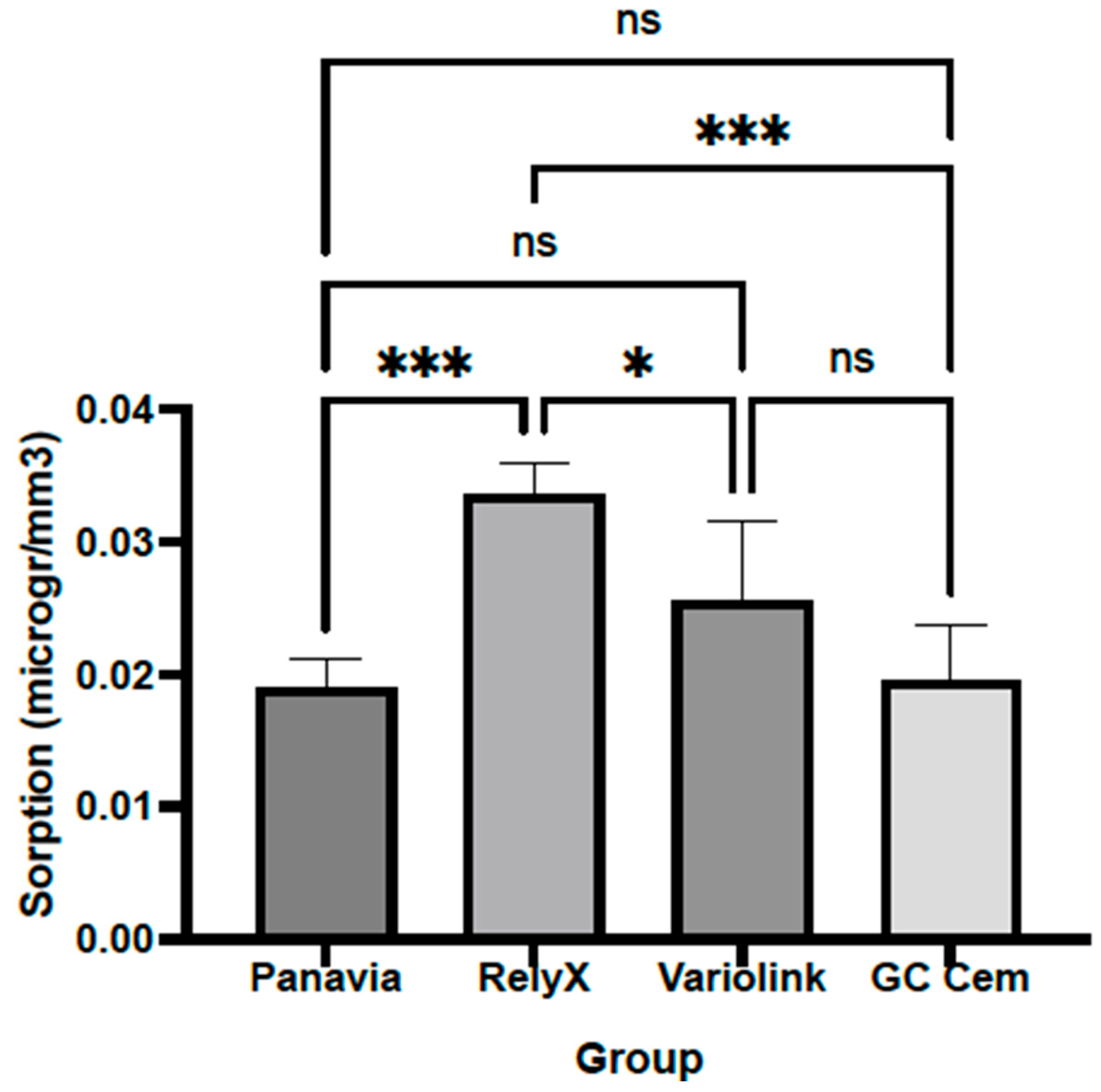
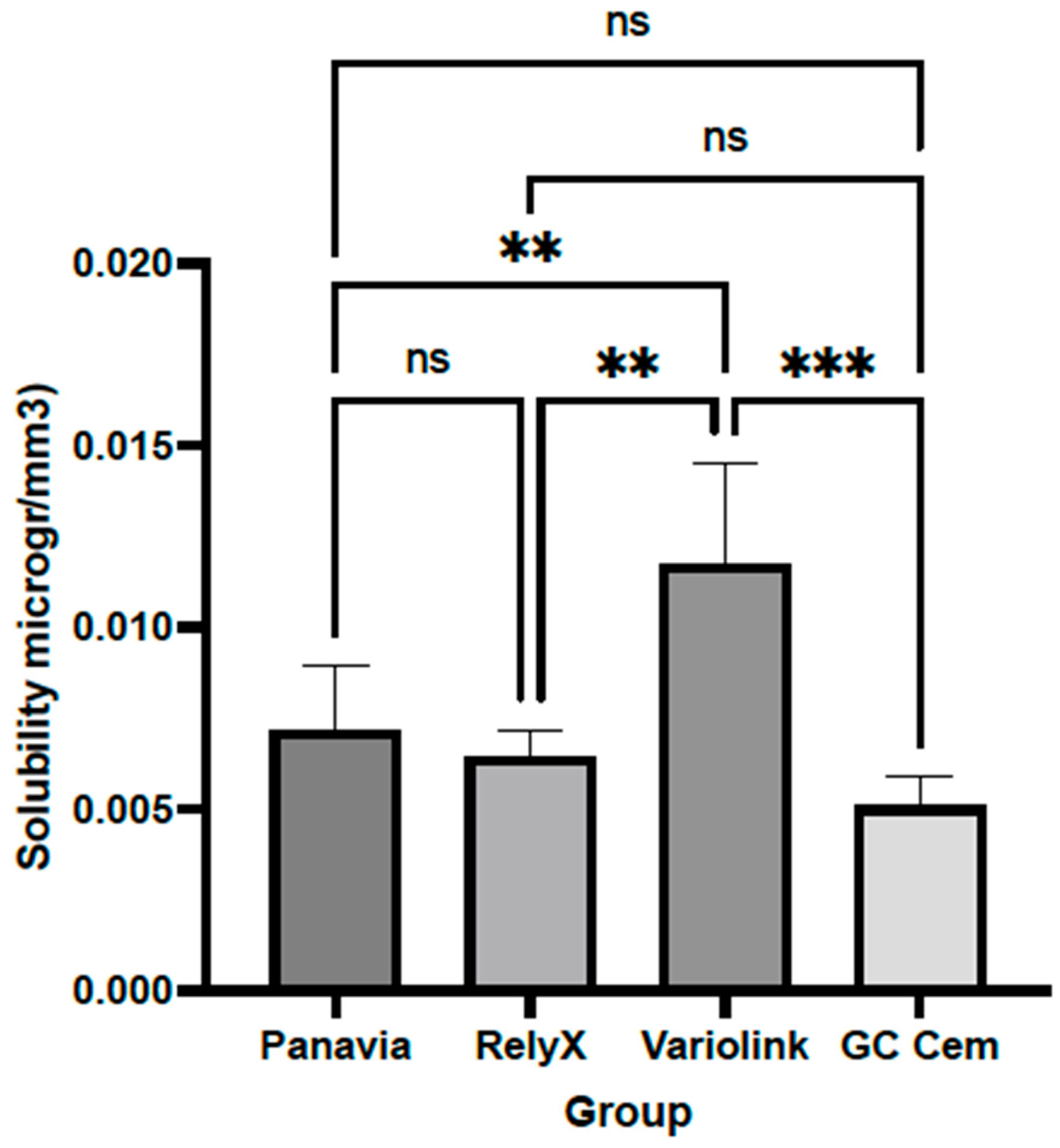
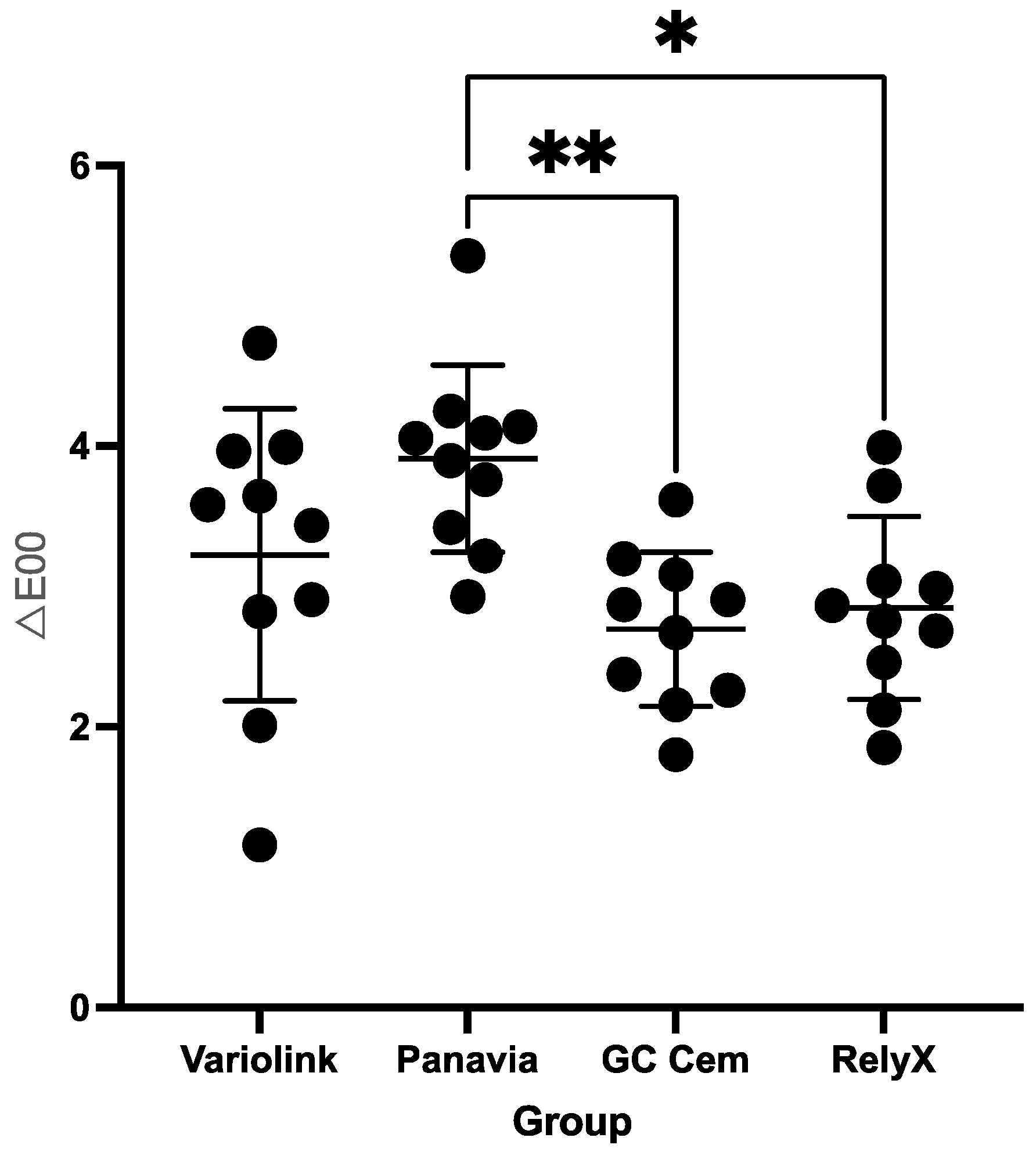
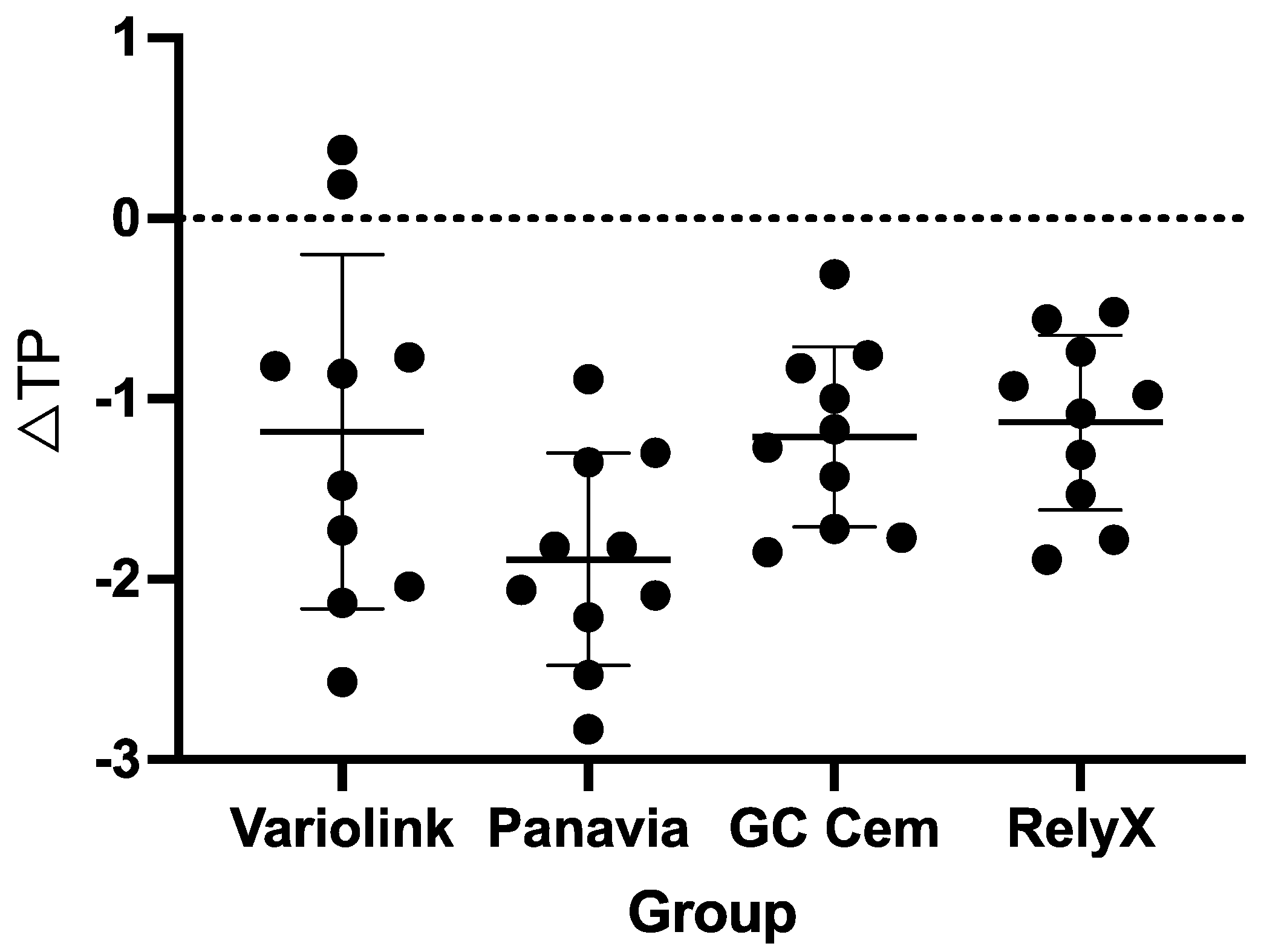

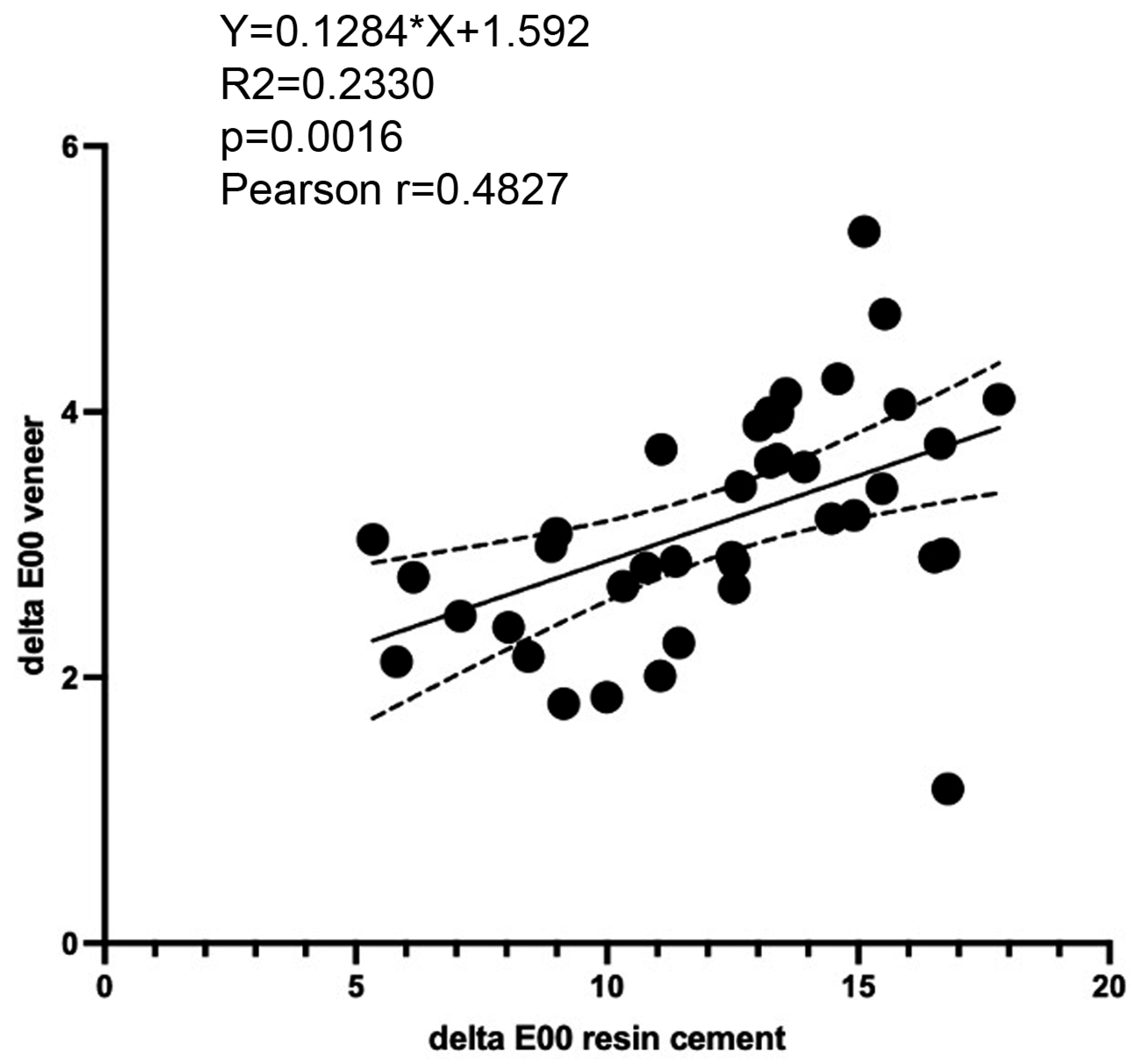
| Material (Code) | Manufacturer | Shade | Adhesion Mode | Composition |
|---|---|---|---|---|
| Curing Mode | ||||
| Variolink Esthetic (Variolink) | Ivoclar Vivadent, Schaan, Liechtenstein | Neutral | Adhesive | Urethane dimethacrylate (UDMA), glycerin-1.3-dimethacrylate, 1,10-decandiol dimethacrylate, ytterbium trifluoride and mixed spheroidal oxide fillers (particle size 0.04 to 0.2 µm, with an average size of 0.1 µm), butylated hydroxytoluene (BHT), initiators, stabilizers, pigments |
| Dual-cured | ||||
| Panavia V5 (Panavia) | Kuraray Noritake, Tokyo, Japan | Clear | Adhesive | Paste A/Paste B Bisphenol A diglycidylmethacrylate (Bis-GMA), triethyleneglycol dimethacrylate (TEGDMA), hydrophobic aromatic dimethacrylate, hydrophilic aliphatic dimethacrylate, initiators, accelerators, silanated barium glass filler (particle size range 0.01–12 µm), silanated fluoroalminosilicate glass filler, colloidal silica bisphenol A Bis-GMA, hydrophobic aromatic dimethacrylate, hydrophilic aliphatic dimethacrylate, silanated barium glass filler, silanated alminium oxide filler, accelerators, dl-Camphorquinone, pigments |
| Dual-cured | ||||
| G-CEM ONE (GC Cem) | GC Corporation, Tokyo, Japan | Translucent | Self-adhesive | Paste A/Paste B 2-Hydroxy-1,3 dimethacryloxypropane, urethane Dimethacrylate (UDMA), titanium dioxide, silicon dioxide and fluoro-almino-silicate glass, 6-tert-butyl-2,4-xylenol, diphenyl(2,4,6-trimethylbenzoyl)phosphine oxide Urethane dimethacrylate (UDMA), 2-Hydroxy-1,3 dimethacryloxypropane, methacryloyloxydecyl dihydrogen phosphate, α,α -dimethylbenzyl hydroperoxide, 6-tert-butyl-2,4-xylenol, and silicon dioxide |
| Dual-cured | ||||
| RelyX Universal (RelyX) | 3M, Seefeld, Germany | Translucent | Universal | Base: phosphorus oxide, silane, terimethoxyctyl-,hydrolysis product with silica, t-Amyl hydroxiperoxide, n2,6-di-tert-butyl-p-cresol, 2-HEMA, methyl methacylate, acetic acid, copper salt, monohydrate Catalyst: diurethanedimethacrylate, ytterbium fluoride, glass powder, surface modified with 2-propenoic acid, 2 methyl-3-(trimethoxysilyl)propyl ester and phenyltrimethoxy silane, TEGDMA, L-ascorbic acid, 6-hexadecanoate, hydrate, silane, trimethoxyoctyl, hydrolysis product with silica, 2-HEMA, titanium dioxide, triphenyl phosphite |
| Dual-cured | ||||
| Initial LiSi Block (LiSi) | GC Corporation, Tokyo, Japan | A1 HT | CAD/CAM block | Fully crystallized lithium disilicate glass ceramic |
| G-aenial Universal Injectable (G-aenial) | GC Corporation, Tokyo, Japan | AO3 | Injectable resin composite | (Octahydro-4,7-methano-1H-indenediyl)bis(methylene) bismethacrylate, 2,2-dimethyl-1,3-propanediyl bismethacrylate, 1,3,5-Triazine-2,4,6-triamine, polymer with formaldehyde, diphenyl(2,4,6-trimethylbenzoyl)phosphine oxide, 2,2′-ethylenedioxydiethyl dimethacrylate, 2-(2H-benzotriazol-2-yl)-p-cresol, Urethane dimethacrylate (UDMA), 6-tert-butyl-2,4-xylenol, ultrafine barium glass fillers (150 nm, ~69 wt%) |
Disclaimer/Publisher’s Note: The statements, opinions and data contained in all publications are solely those of the individual author(s) and contributor(s) and not of MDPI and/or the editor(s). MDPI and/or the editor(s) disclaim responsibility for any injury to people or property resulting from any ideas, methods, instructions or products referred to in the content. |
© 2025 by the authors. Licensee MDPI, Basel, Switzerland. This article is an open access article distributed under the terms and conditions of the Creative Commons Attribution (CC BY) license (https://creativecommons.org/licenses/by/4.0/).
Share and Cite
Miletic, V.; Pour Ronagh, A. Staining Analysis of Resin Cements and Their Effects on Colour and Translucency Changes in Lithium Disilicate Veneers. Polymers 2025, 17, 362. https://doi.org/10.3390/polym17030362
Miletic V, Pour Ronagh A. Staining Analysis of Resin Cements and Their Effects on Colour and Translucency Changes in Lithium Disilicate Veneers. Polymers. 2025; 17(3):362. https://doi.org/10.3390/polym17030362
Chicago/Turabian StyleMiletic, Vesna, and Asana Pour Ronagh. 2025. "Staining Analysis of Resin Cements and Their Effects on Colour and Translucency Changes in Lithium Disilicate Veneers" Polymers 17, no. 3: 362. https://doi.org/10.3390/polym17030362
APA StyleMiletic, V., & Pour Ronagh, A. (2025). Staining Analysis of Resin Cements and Their Effects on Colour and Translucency Changes in Lithium Disilicate Veneers. Polymers, 17(3), 362. https://doi.org/10.3390/polym17030362







